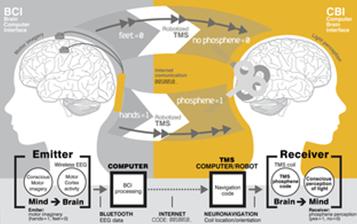Sep 11 2014
An international study published on the open access journal PLOS ONE provides the first demonstration of conscious brain-to-brain communication in humans.
 Previous studies had already demonstrated the communication between a human brain and a mouse, but technologies had not succeeded in communicating two human brains yet.
Previous studies had already demonstrated the communication between a human brain and a mouse, but technologies had not succeeded in communicating two human brains yet.
Researchers have achieved internet-mediated direct communication between the minds of two people separated by 7,800 kilometres by using non-invasive technologies. The study is co-led by Carles Grau, researcher in the Department of Psychiatry and Clinical Psychobiology at the University of Barcelona (UB) and science consultant at the company Starlab, and Giulio Ruffini, from Barcelona’s companies Starlab and Neuroelectrics. Researchers from Harvard University (Dr Pascual-Leone) and the French company Axylum Robotics have also participated in the research.
The milestone took place on 28 March when the word hola was transmitted from Thiruvananthapuram (India), where the emitter was, to the brain of the receiver, who was in Strasbourg. The word was translated into binary, a code composed by numbers 1 and 0. A total of 140 bits were encoded and send via Internet by means of pioneering technologies.
The emitter wore a device —a kind of helmet— that registered electroencephalographic changes of emitter’s brain when thinking the word hola in binary code. The emitter subject was instructed to envision actions for each piece of information: thinking he was moving his hands for a 1 or his feet for a 0, until the word was completely encoded.
Light flashes in the brain
The receiver got the message via Internet by means of a robotized computer-brain interface which turned the 140 bits that compose the word into phosphenes: light flashes. Light flashes are delivered in a pattern, which needs to be consciously perceived and deciphered by the recipient subject who wore a blindfold to block out other visual stimuli. The perception of a flash by receiver subject corresponded to a 1 in the emitter's message, while the absence of a flash corresponded to a 0. The experiment was successfully repeated ten days later using the word ciao.
Previous studies had already demonstrated the communication between a human brain and a mouse, but technologies had not succeeded in communicating two human brains yet. “In this study, we have achieved conscious brain-to-brain communication”, explains Carles Grau, expert in neuroscience and member of the Research Group on Cognitive Neurodynamics and Mental Disorders of UB. “In fact —he highlights—, we can use the term mind-to-mind transmission because both, emitter and receiver human subjects, participate consciously”.
New ethical and legal challenges
This pioneering study is an important technological achievement that opens new research venues, like the direct and non-invasive transmission of feelings and emotions or the direct connection of external sensors (recording information not accessible to our natural sensory organs) with the human brain by means of non-invasive brain stimulation.
“Computers in the not-so-distant future will be able to directly interact with the human brain in a fluent way; thus, they will support brain-to-computer communication as well as brain-to-brain communication routinely”, points out Carles Grau. “Therefore —he adds—, the wide use of these brain-to-brain communication technologies may create new human interaction possibilities that will involve social implications and require new ethical and legal responses”.
The study has been partly funded by the project HIVE, within the European Union FET programme, the companies Starlab and Neuroelectrics, and the Research Group on Cognitive Neurodynamics and Mental Disorders of UB.